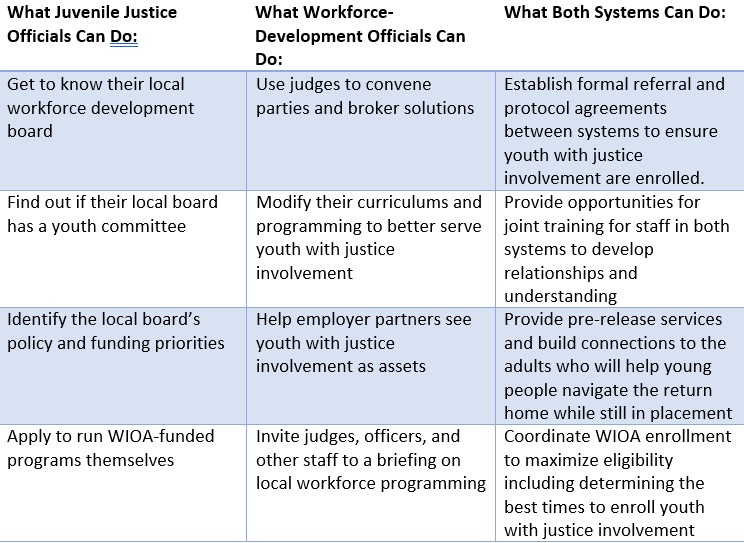Jobs and Training for Youth with Justice Involvement: How WIOA Funding Can Help
Remarkable progress has been made to decrease juvenile incarceration. Despite this progress, 48,000 young people in 2019 were in secure facilities. Access to education, training, and employment is a missing piece of the puzzle for many of these young people, and for those at other stages of justice involvement.
The good news is that we know what works to connect young people to employment. Like other adolescents, youth with justice involvement need blended education and training, access to paid work experiences, connections to caring adults, and the supports to ensure they succeed. The federal workforce-development provides access to many of these proven practices and experience and prioritizes resources for youth with justice involvement.
Today the National Youth Employment Coalition, with support from the Annie E. Casey Foundation, is releasing Job Training for Youth with Justice Involvement: A Toolkit. The toolkit will help leaders and practitioners in both the juvenile justice system and workforce development system collaborate to effectively serve youth with justice involvement. As the COVID-19 pandemic exacerbates wide disparities between these vulnerable youth and their peers, this work is more relevant now more than ever.
WIOA Prioritizes Out-of-School Youth (OSY): One of the biggest changes enacted in the 2014 Workforce Innovation and Opportunity Act (WIOA) was the requirement that at least 75 percent of funding for youth services go to out-of-school youth (OSY). Youth with justice involvement will, in nearly all cases, qualify as OSY and can receive leadership development, mentoring, employment training, work experience, and postsecondary preparation among other services. Programs with a long history of serving youth with justice involvement, like South Bay Community Services (SBCS) in San Diego, now use WIOA funding to cover much of their services for the population, including internships, career coaches, and support services such as counseling, anger management, and social skill-building. The toolkit includes detailed case studies of SBCS, as well as Our Piece of the Pie in Hartford, Conn., Pacific Mountain Workforce Development Council’s My JOB program in Washington State, the Chatham County (Ga.) juvenile court system, and the nationwide efforts of the Compass Rose Collaborative.
Making WIOA Work for Youth with Justice Involvement: While Congress intended for WIOA to enable the workforce-development system to serve the hardest-to-serve young people, disincentives at the federal level, policies at the state and local level, program preferences and practices and even organizational cultures often stand in the way of this goal. The guide offers a hands-on look at how to overcome the most common barriers to serving youth with justice involvement, such as allowing for self-attestation, renegotiating performance targets, enhancing and extending programming and requesting waivers.
Building Partnerships and Connecting Systems are Key to Success: Workforce development must be available to youth at any stage of the juvenile or criminal justice systems, as an alternative to system involvement, while on probation, as an alternative to residential placement or confinement, while in placement or post-release and under aftercare or parole supervision. But leaders and frontline staff in these systems operate under different constraints and may speak different professional languages. The toolkit includes a synthesis of research on effective interagency partnerships, to guide users as they seek to form durable bonds across systems.
Both Systems Must Work Together: The toolkit also identifies actions for officials in juvenile justice and in workforce development to take, as illustrated in the below table.

Collaboration between juvenile justice and workforce development systems can achieve better outcomes for young people, result in more efficient use of public dollars, improve community safety and make the efforts of officials in both systems more effective. These are powerful motivators, as is the fact that WIOA intentionally and explicitly calls for the workforce-development system to serve the most challenged and disconnected young people.
As the COVID-19 pandemic inflicts lasting damage on young adults’ prospects in the job market, there has never been a more important time to seek the kinds of cross-system collaboration described by this toolkit. Hopefully, the ideas, tools, and stories shared here point the way.
View Report: Job Training for Youth with Justice Involvement: A Toolkit
